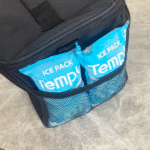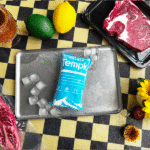Refrigerated Dry Ice Pack Sheet: How Do You Choose?
If you ship frozen or sub‑zero goods, un refrigerated dry ice pack sheet is the most predictable way to hold −78.5°C for 24–96 hours. Dans ce guide, you’ll size the right mass, select better wraps, meet UN 1845 règles, and validate performance. I’ll also cover 2025 trends so your refrigerated dry ice pack sheet delivers fewer excursions, réduire les coûts, and easier audits.
-
What exactly makes a refrigerated dry ice pack sheet high‑performance for your lanes?
-
How do you size a refrigerated dry ice pack sheet for 24–96 hours with minimal waste?
-
Which safety steps, étiquettes, and SOPs apply to a refrigerated dry ice pack sheet?
-
How to compare suppliers, validate results, and reduce total landed cost
-
When to blend a refrigerated dry ice pack sheet with PCM or gels
What is a refrigerated dry ice pack sheet, and why now?
A refrigerated dry ice pack sheet is a vapor‑permeable sleeve or matrix containing dry ice pellets or mini‑blocks, engineered for safe venting and clean handling. It delivers consistent cold, resists tearing, and fits a variety of coolers and shippers. The design prevents dust, controls CO₂ release, and reduces housekeeping.
En termes simples, you get frozen performance that feels as easy as using a gel pack sheet. You drop it in, close the lid, and trust the clock. UN refrigerated dry ice pack sheet is portable, empilable, and labeled for quick audits. Reliability matters more in 2025 as lanes tighten and carriers compress sort windows. Predictability lowers reships and defends your margin during peak season.
How does construction affect a refrigerated dry ice pack sheet?
Look for dense pellets, uniform fill, reinforced seams, and breathable film. Blocks extend hold time; pellets fill voids and speed pull‑down. Hybrid layouts combine both behaviors. The “sheet” format keeps pellets in place, so packouts are repeatable across shifts.
| Construction Feature | Typical Benefit | Typical Trade‑off | Ce que cela signifie pour vous |
|---|---|---|---|
| Dense pellets (3–16mm) | Troussant rapide, better void fill | Slightly faster sublimation | Fewer warm spots in mixed loads |
| Mini‑blocks in sheet cells | Longer hold time | Less flexible fit | Better for long or delayed lanes |
| Reinforced seams | Fewer tears and leaks | Slight cost premium | Cleaner operations, fewer reworks |
| Vapor‑permeable film | Safe CO₂ venting | Needs intact wrap | Safer storage and transit |
Note de terrain: A coastal seafood brand swapped loose pellets for a refrigerated dry ice pack sheet with reinforced seams. Cleaning time dropped, labels stayed legible, and claims fell during summer.
How do you size a refrigerated dry ice pack sheet for 24–96 hours?
Start with lane hours, Classe d'expéditeurs, masse de charge utile, and starting temperature. Convert total heat gain into dry ice mass, then translate mass into the number of sheets. Overfilling increases cost and risk; underfilling drives excursions and chargebacks. Ton refrigerated dry ice pack sheet vendor should provide lane‑specific tables and seasonal adders.
Short version: plan for the route you actually run plus a realistic delay. If your product loads warm, include a pull‑down adder or pre‑condition it. When you upgrade insulation, reduce sheet count instead of letting “free cold” evaporate.
Quick estimator for a refrigerated dry ice pack sheet
Planning ranges (adapt to your SKUs)
| Target Hold Time | Basic Shipper | Premium Shipper | Ultra Shipper | What this means |
|---|---|---|---|---|
| 24 heures | 3–4 lb (1–2 sheets) | 2–3 lb (1–2 sheets) | 2 kg (1 feuille) | Better insulation reduces mass |
| 48 heures | 6–8 lb (3–4 sheets) | 5–6 lb (2–3 draps) | 4–5 lb (2–3 draps) | Ajouter 10% during summer |
| 72 heures | 10–12 lb (5–6 sheets) | 8–10 lb (4–5 draps) | 7–8 lb (3–4 sheets) | Mix blocks with pellet cells |
| 96 heures | 14–18 lb (7–9 sheets) | 12–15 lb (6–7 sheets) | 10–13 lb (5–6 sheets) | Validate with loggers first |
Pour la pointe: Replace one pellet‑only refrigerated dry ice pack sheet with a mini‑block sheet for lanes prone to courier delays. You’ll keep hold time without adding much weight.
Which materials help a refrigerated dry ice pack sheet last longer?
Material choice is your biggest lever after insulation. Sheets using food‑grade or pharma‑grade CO₂ improve cleanliness. Tight pellet size distribution ensures consistent packing. Breathable films manage CO₂ safely while resisting abrasion. Semi‑rigid cells keep media in place even when the shipper gets jostled.
Boulettes, mini‑blocks, and hybrids—what should you choose?
-
Pellet‑dominant sheets: best for uneven payloads and fast pull‑down.
-
Mini‑block sheets: best for long lanes; fewer surfaces exposed to heat.
-
Hybrid sheets: a pellet core with rigid edges; balanced performance and clean handling.
| Sheet Type | Mieux pour | Watch-bots | Avantage pratique |
|---|---|---|---|
| Pellet sheet | Mixed shapes, Rapid Cool-Down | Slightly faster loss | Fills gaps and reduces hot spots |
| Mini‑block sheet | 72–96 hour lanes | Less flexible fit | Long, predictable hold time |
| Hybrid sheet | Busy operations | Small cost premium | Clean handling plus strong cold |
Reality check: If operators vary placement, Utiliser un refrigerated dry ice pack sheet with printed “THIS SIDE UP” and seam reinforcement. You get fewer tears and faster training for new staff.
Safety and compliance for a refrigerated dry ice pack sheet (Et 1845)
Dry ice is UN 1845, une classe 9 bien dangereux, so labeling and venting matter. UN refrigerated dry ice pack sheet should arrive with clear guidance on net mass, chemins de ventilation, EPP, and disposal. Air shipments require carrier‑specific limits. Ground shipments still need ventilation and training.
Keep SDS on file. Never seal a dry ice packout in a fully airtight container. Train handlers on cryogenic gloves and eye protection. Keep sheets off wet floors to avoid sticking and tearing. Use orientation arrows and photos in your SOP to reduce mistakes on busy shifts.
Liste de contrôle de la conformité (copy/paste into your SOP)
-
Et 1845 mark plus net dry ice mass where required
-
Classe 9 label as applicable and package venting paths
-
Photo‑based SOP for refrigerated dry ice pack sheet placement
-
EPP: cryogenic gloves and eye protection at every station
-
SDS access and annual training records for audits
| Exigence | Air Shipment | Ground Shipment | Pourquoi ça compte |
|---|---|---|---|
| Et 1845 + masse nette | Always | Souvent | Faster inspections and fewer holds |
| Ventilation | Always | Always | Empêche la construction de la pression |
| Driver instructions | Carrier‑specific | Recommended | Safer delivery, fewer claims |
| Entraînement & SDS | Oui | Oui | E‑E‑A‑T, worker safety, conformité |
Validation SOP for a refrigerated dry ice pack sheet
Validation proves your packout works before scale. Run pilots in summer and winter on the longest lane. Include a planned delay. Place the data logger near the payload’s warmest point. Lock the SOP only after the refrigerated dry ice pack sheet passes without manual re‑icing.
A lean validation blueprint
-
Define success: temperature band, heures, and allowed spike time.
-
Build SOP: step‑by‑step photos showing sheet placement and orientation.
-
Run tests: normal lane plus a 12–24 hour delay scenario.
-
Analyze: mean, min, max, and time over threshold.
-
Roll out: former, audit quarterly, and update seasonally.
Actual outcome: After switching to a refrigerated dry ice pack sheet with mini‑blocks, a diagnostics network cut average dry ice mass from 12 livre à 8 lb and reported zero excursions across 40 pilot shipments.
Emballages hybrides: refrigerated dry ice pack sheet + PCM or gel
Blend when your product can tolerate higher setpoints or when seasons swing. UN refrigerated dry ice pack sheet maintains deep‑frozen conditions; PCM or gel smooths the curve and cushions fragile goods. During shoulder seasons, a thin PCM lid above the sheet can reduce total CO₂ while preserving margin.
Combining media without surprises
-
Keep payload off direct contact using a corrugate tray when frost is a risk.
-
Place a PCM lid to buffer openings and protect labels from condensation.
-
Validate both components together; mixed systems behave differently.
| Hybrid Setup | Frozen SKUs | Chilled SKUs | Your take‑away |
|---|---|---|---|
| Mini‑block sheet + PCM lid | Excellent | Overkill | Longue tenue + shock protection |
| Pellet sheet + packs de gel | Not for frozen | Ideal | Shoulder‑season savings |
| Pellet‑base + mini‑block topper | Excellent | N / A | Faster pull‑down with longer hold |
Cost and ROI: how a refrigerated dry ice pack sheet pays back
Predictable cold lowers re‑icing, réclamations, and courier surcharges. Unit price can be misleading; failures are expensive. A clean refrigerated dry ice pack sheet réduit la poussière, protects labels, and speeds packing. Add a low‑cost data logger and you can end disputes with facts.
Levers you can control this quarter
-
Right‑size mass: Avoid “just add more” habits that waste 20–30%.
-
Améliorer l'isolation: Better R‑value cuts sheet count by one or two.
-
Consolidate SKUs: Two or three refrigerated dry ice pack sheet sizes cover most orders.
-
Standardiser les SOP: QR or photo steps raise first‑shift and night‑shift consistency.
-
Instrument lanes: Even basic loggers reduce claims and speed approvals.
| Cost Component | What you pay | Sheet impact | Practical result |
|---|---|---|---|
| Masse de glace carbonique | Per pound | Less with Premium/Ultra | Fewer courier surcharges |
| Packaging labor | Per order | Faster with sheet format | Shorter cycle time |
| Housekeeping | Per shift | Less dust and debris | Cleaner stations |
| Claims | Per failure | Fewer excursions | Defend revenue and CX |
Supplier scorecard for refrigerated dry ice pack sheet vendors
Ask for data, not adjectives. Credible partners publish CO₂ purity, pellet size distribution, seam durability, and permeability. They provide lane modeling, validation support, and regional hubs to ship fresher sheets with less transit loss. SKUs should stay consistent season to season so your SOP doesn’t drift.
Copy this scorecard
| Criterion | Acceptable | Best‑in‑Class | Why you care |
|---|---|---|---|
| CO₂ purity | Qualité alimentaire | Pharma‑grade | Clean payload environment |
| Pellet variance | ±3 mm | ±2 mm | Consistent packouts |
| Seam strength | Single stitch | Reinforced seams | Fewer tears |
| Permeability | Meets vent spec | Tested across temps | Safer storage |
| Hubs & lead time | 1–2 hubs | 3+ hubs | Fresher refrigerated dry ice pack sheet |
Sourcing moves that work: Request three lane‑matched validations from the last 12 mois. Confirm next‑day availability in peak season. Map SKUs to SOP steps so new staff can follow without guesswork.
Field use: refrigerated dry ice pack sheet for travel and labs
Outside parcel networks, openings and ambient swings are bigger risks. Pour le camping, restauration, or field labs, treat a refrigerated dry ice pack sheet like a small stove: ventilé, handled with gloves, and never inside sealed tents or cars. Consider one spare sheet as a deliberate buffer.
Field‑ready guidance
-
Use latching coolers with gasketed lids and a small vent crack.
-
Add a cardboard tray between sheet and food to avoid freezer burn.
-
Pack in layers: base mini‑block sheet, charge utile, pellet topper.
-
Expect shorter life in hot or windy conditions; plan an extra sheet.
| Scénario | Conseil | Why it helps | Real‑world impact |
|---|---|---|---|
| Road trip | Vent the cooler slightly | Prevents pressure | Manipulation plus sûre |
| Multi‑day hike | Block base + pellet topper | Longue tenue + fit | Fewer resupplies |
| Field lab | Logger inside cooler | Data for notes | Repeatable setup |
2025 trends in refrigerated dry ice pack sheet solutions
Dans 2025, operations lean toward hybrid sheets with reinforced seams, compact SKUs, and simple QR SOPs. Regional hub networks reduce mass variability, so teams can trim buffers without raising risk. Recyclable liners are replacing EPS in moderate lanes, and small, disposable data loggers are becoming default.
Derniers développements en un coup d'œil
-
Hybrid cells: Pellets inside semi‑rigid cells resist abrasion and extend hold time.
-
QR playbooks: Scannable steps standardize refrigerated dry ice pack sheet placement.
-
Greener liners: Lighter shippers lower courier fees and waste without sacrificing performance.
Perspicacité du marché: Many shippers cover 80% of orders with just two refrigerated dry ice pack sheet sizes plus seasonal adders. This reduces training time and picking errors while keeping claims low.
FAQ: refrigerated dry ice pack sheet
How cold is a refrigerated dry ice pack sheet, and how long will it last?
It targets −78.5°C and typically holds for 24–96 hours depending on shipper class, sheet mass, et chaleur ambiante. Add 10–20% in summer.
Can I combine a refrigerated dry ice pack sheet with PCM or gel?
Oui. Use the sheet for frozen control and PCM or gel to cushion and smooth openings. Validate both together.
Do I need special labels for a refrigerated dry ice pack sheet?
Air shipments usually require UN 1845 and net mass with clear venting. Ground shipments still need ventilation and training.
How many sheets do I need for 48 heures?
A premium shipper often needs 5–6 lb total, or two to three refrigerated dry ice pack sheet units. Round up to your SKUs.
Is a refrigerated dry ice pack sheet safe in cars or tents?
Only with ventilation. Never seal in confined spaces. Use gloves and keep the cooler cracked for airflow.
Can a refrigerated dry ice pack sheet ship internationally?
Oui, but expect carrier rules, retards de douane, and longer lanes. Validate your longest route and add buffer mass.
How should I dispose of a refrigerated dry ice pack sheet after delivery?
Let remaining dry ice sublimate in a ventilated area, then recycle packaging if possible. Avoid drains and sealed bins.
Résumé et recommandations
A refrigerated dry ice pack sheet delivers predictable sub‑zero control, manipulation plus sûre, and lower total cost when matched to your lanes. Size by hours and insulation, Pas de supposition. Validate in summer and winter with data loggers. Standardize SKUs, reinforce training with photo SOPs, and use hybrid sheets where lanes are variable.
Étapes suivantes:
-
Map your top three lanes and worst‑case hours.
-
Pilot two packouts using a refrigerated dry ice pack sheet with different shipper classes.
-
Validate with loggers, lock the SOP, and review quarterly.
CTA: Need help sizing and validating your sheet setup? Ask Tempk for a no‑cost lane model and pilot plan.
À propos du tempk
We design practical cold chain systems around the refrigerated dry ice pack sheet, premium insulation, and simple SOPs. Our team supports lane modeling, seasonal validation, and regional fulfillment to keep sheets fresh and predictable. Customers report fewer excursions and faster approvals after standardizing on our sheet‑based pack families.
Ready to improve reliability? Request a lane assessment and pilot schedule with Tempk.























